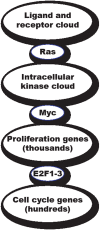Finding cancer's weakest link
- PMID: 22202195
- PMCID: PMC3282087
- DOI: 10.18632/oncotarget.396
Finding cancer's weakest link
Abstract
The biological programs of vertebrates exhibit a remarkable degree of functional degeneracy, adaptive compensation and robustness, to preserve homeostasis and generate reproducible phenotypic outputs irrespective of variations in signal strength, noise and quality. Cancers are difficult to treat not only because they are so mechanistically diverse but also because they adapt or evolve in response to any pharmacological elective pressure we impose upon them. Hence, an ideal cancer drug target would exert a function both necessary for cancer cell survival and functionally non-redundant, rendering it impossible for tumor cells to compensate for, or evolve independence from, the inhibitory effect of any drug aimed at that target. In this review, we discuss the unique, non-degenerate and highly pleiotropic role played by Myc in coordinating, engaging and maintaining the diverse intracellular and extracellular programs required for cell proliferation in vivo. These properties make Myc a compelling candidate cancer drug target, at least in principle: an assertion recently reinforced by new in vivo genetic data.
Figures

References
-
- Coussens LM, Fingleton B, Matrisian LM. Matrix metalloproteinase inhibitors and cancer: trials and tribulations. Science. 2002;295(5564):2387–2392. - PubMed
-
- Fingleton B. Matrix metalloproteinase inhibitors for cancer therapy:the current situation and future prospects. Expert Opin Ther Targets. 2003;7(3):385–397. - PubMed
-
- Miller KD, Sweeney CJ, Sledge GW., Jr. Can tumor angiogenesis be inhibited without resistance? EXS. 2005;(94):95–112. - PubMed
Publication types
MeSH terms
Substances
LinkOut - more resources
Full Text Sources

